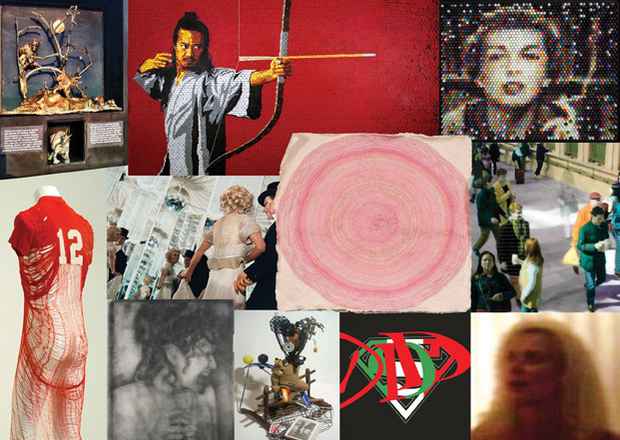"What's My Line?" Exhibition
Kim Foster Gallery

This event has ended.
"What's My Line?" was a game show that aired from 1950 to 1967 in which panelists attempted to determine the occupation, or in the case of a famous "mystery guest," the identity, of the contestant. Much like the game show, the artists in this exhibition use elements of mystery, disguise and deception in their depictions of the famous, the infamous, and the nameless, evoking myriad responses from the viewer.
William Brovelli and Sherry Karver assign identities to nameless people. Brovelli portrays movie "extras" culled from classic films. Star status seems to escape the extra, but then again so does obscurity.The "extra" works under the uncertainty of not being fully sure of when or if the camera will capture them. Karver uses images of crowded places, and creates fictional narratives of the inner thoughts of selected subjects. Among them could be doctors, lawyers, teachers, immigrants, or thieves.
Christian Faur, Karen Shaw, D Dominick Lombardi and John H Howard rely on sculptural elements to flesh out their content. Faur casts thousands of encaustic crayons to create this series of portraits based on "50s commercials." Using the pointed ends of these 'crayons' to make the features and color modulations in the faces, the portraits look from afar both abstracted and recognizable at the same time. Shaw painstakingly unravels sports clothing.A short macho t-shirt becomes a very long, delicate, gossamer ball gown. Her purpose is to subvert gender, uniforms into ball gowns, men's clothes into women's wear. Lombardi's "Urchins" are lost souls. Discarded objects and sand constitute the core of their human forms.The nature of Lombardi's creations exposes a fatal disconnect between the inner and outer urchin, one that can be found in most of us between the unfulfilled human being and the satisfied consumer filled with cheap and hopeless goods. Howard vigorously "documents the process of accelerated evolution observed in cross species reproduction on a small island infected by non-benign, quadrupedal gastropods from planetoid deposits." This story is utter fiction, a product of his active imagination.
Susan Wides, Antonio Petracca and E.E. Smith orchestrate a fabrication of reality. Wides' photographs of wax figures collapse the distinctions between factual and fictional worlds. All public figures, real or imagined, blur into a succession of idols. Wides' photographs expose not only fictional authenticity of wax figures but also, more importantly, the ways in which commercial legends become facts of history. Petracca exposes the generalizations and stereotyping that is ubiquitous in our social media. His melding of the authentic with parody comments on the reliance of the media to resort to caricature as a "stand in" for cultural identity. Smith reproduces a bridal portrait that refers to a personal history and, simultaneously, to a more collective or shared experience.The partial blurring creates an image that seems to fade as the viewer moves closer, evoking the sensation of a memory that is at once vivid, yet distant.
Media
Schedule
from November 15, 2012 to December 22, 2012
Opening Reception on 2012-11-15 from 18:00 to 20:00